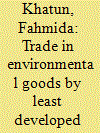|
|
|
Sort Order |
|
|
|
Items / Page
|
|
|
|
|
|
|
| Srl | Item |
| 1 |
ID:
154687


|
|
|
|
|
| Publication |
Dhaka, Centre for Policy Dialogue, 2015.
|
| Description |
xviii, 101p.: tables, figures, diagramhbk
|
| Standard Number |
9789843399847
|
|
|
|
|
|
|
|
|
|
|
|
Copies: C:1/I:0,R:0,Q:0
Circulation
| Accession# | Call# | Current Location | Status | Policy | Location |
| 059156 | 305.42095492/KHA 059156 | Main | On Shelf | General | |
|
|
|
|
| 2 |
ID:
172214


|
|
|
|
|
| Summary/Abstract |
Technological advancement can displace workers with machines, but also create new jobs. Hence, at the crux of the matter lies a race between the rate of technological advancement and the pace at which educational institutions can empower workers with the right skills. For the countries of the South Asian region, generating jobs for youth will prove to be a challenge in the backdrop of the Fourth Industrial Revolution. This paper investigates the impact of technological advancement on youth unemployment in the context of six South Asian countries, namely, Bangladesh, Bhutan, India, Nepal, Pakistan and Sri Lanka. The results of the panel instrumental variables model estimations show that lower secondary completion rate has a negative relationship and capital–labour ratio has a positive relationship with the share of youth not in employment, education or training. However, since the magnitude of the coefficient of the lower secondary completion rate is greater than the magnitude of the coefficient of the capital–labour ratio, it is concluded that education will win the race against technology in South Asia, as long as the educational attainment rates are high enough to offset the impact of technical progress.
|
|
|
|
|
|
|
|
|
|
|
|
|
|
|
|
| 3 |
ID:
183736


|
|
|
|
|
| Summary/Abstract |
Inequality in the distribution of income can be beneficial or detrimental for economic growth depending on the level of inequality. This study advocates that when income inequality is low, increase in income inequality increases economic growth, whereas when income inequality is high, increase in income inequality decreases economic growth. The level of inequality that maximizes economic growth is defined as the optimum level of income inequality. This article attempts to determine the optimum level of income inequality for South Asia through an econometric analysis. It uses panel data from Bangladesh, India, Nepal, Pakistan and Sri Lanka, over a 34-year period to undertake a systematic investigation using panel instrumental variables techniques. The results of this study confirm that an optimum level of income inequality does exist, and occurs at a Gini coefficient value of 0.4492. Thus, this research empirically confirms that the relationship between income inequality and economic growth is non-linear. Further calculations show that for an economy that is at the optimum level of income inequality, the per capita gross domestic product can be expected to double within approximately 13 years, provided all other factors are held constant. However, a change in the Gini coefficient by 0.10 units in either direction—higher or lower—away from the optimum level, can increase the number of years for the per capita gross domestic product to double by 55 to 57 years, depending on the method of approximation.
|
|
|
|
|
|
|
|
|
|
|
|
|
|
|
|
| 4 |
ID:
120076


|
|
|
|
|
| Publication |
2012.
|
| Summary/Abstract |
Liberalization of environmental goods and services as laid out in the work programme of the Doha Ministerial Declaration of the World Trade Organization has implications for least developed countries as these countries are vulnerable to climate change. They need to follow and participate in the negotiation in order to achieve market access opportunities for environmental goods and services of their interests in the global market and to access cleaner technologies at an affordable price. Such participation will be meaningful if it is backed by informed arguments based on analytical exercise. This article estimates that export of environmental goods by least developed countries stood at 0.08 per cent and import at 0.82 per cent of global exports and imports of environmental goods, respectively, in 2007. The article suggests that even with low trade, least developed countries stand to gain through reduction of tariff and non-tariff barriers on environmental goods. This will, however, have to be combined with appropriate technology transfer and adequate financial support.
|
|
|
|
|
|
|
|
|
|
|
|
|
|
|
|
|
|
|
|
|